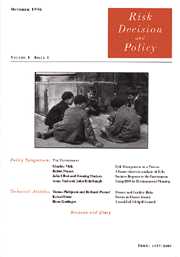Article contents
The effectiveness of physician risk management: Potential problems for patient safety
Published online by Cambridge University Press: 02 January 2001
Abstract
Physician risk management (RM) has been mandated around the world in an effort to reduce pecuniary and non-pecuniary loss associated with avoidable patient injury. However, there has been little empirical RM assessment to determine whether physicians obtain an increased understanding of the law, clinical obligations defined by law, and reduced numbers of injury suits. Here, 210 US primary care physicians were sent a survey requesting demographic information on RM activities, the definition of negligence, and evaluation of ten patient injury jury verdict case scenarios; 138 physicians responded. Although physicians participated in a broad array of RM activities, none were positively associated with overall concordance with case verdicts; indeed, substantive self-study and RM seminar attendance <24 months ago were associated with worse concordance. Recent RM seminar attendance, clinical practice guideline (CPG) use, and self-study were associated with worse concordance in defendant verdict cases; CPG use was correlated with better concordance in plaintiff verdict cases. Respondent physicians were significantly harsher in case evaluations overall when they used insurer CPGs and for defendant verdict cases when they used insurer CPGs, engaged in substantive self-study, or recently attended RM seminars. No RM method was found to correlate with successful jury verdict prediction; having been sued was negatively correlated with defendant verdict case prediction. Finally, respondent physicians had a higher number of patient injury suits associated with participation in RM malpractice training at the training site, RM seminar training, and RM seminar attendance <24 months ago, or if they acted as an expert/consultant in malpractice cases. Most physicians could not identify the rule of negligence; yet correct identification of the negligence rule was not correlated with concordance, prediction, or number of patient injury suits. Thus, physician RM efforts may not be effective in promoting patient safety, may increase risk of patient injury, and may not reduce pecuniary and non-pecuniary costs associated with patient injury.
- Type
- Technical article
- Information
- Copyright
- © 2000 Risk Decision and Policy
- 5
- Cited by


